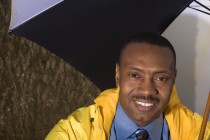A word of warning to the victorious.
Election results are in, and as reported on the AMS web site, J. Marshall Shepherd of the Univ. of Georgia is our new President-Elect. He’ll become President for a year starting at the 2013 Annual Meeting.

But…first, Shepherd must survive our upcoming meeting, which will transform the New Orleans Convention Center into a buzzing hive of meteorological activity.
The first big test of the President-Elect’s resolve will be the temptation to check out the poster by Paul Croft et al. on Monday 23 January (2:30 p.m.-4 p.m., Hall E) about how students have been tracking insect species as part of an overall study of cranberry bog restoration in New Jersey and how this might affect local weather. Then there’s a poster on Thursday (9:45-11 a.m., Hall E) by Sarah Tessendorf (NCAR) et al. on how pine bark beetles affect the microclimate (and ultimately snowpack) in Colorado mountain forests.
But the real test will be “The Vector Mosquito Aedes Aegypti At the Margins,” presented by Andrew Monaghan (NCAR) et al. Monday at 2 p.m. (Room 333). Monaghan and his colleagues have taken their research to the hinterlands to solve the question of what environmental and social factors affect breeding and movement of mosquitos carrying Dengue Fever.
Simple measures of temperature changes or degree days might work in tracking the behavior of some mosquito borne disease (like the outbreaks of West Nile Virus in the American Midwest), but they aren’t adequate in this sensitive climate-health interaction run amuck.
In the last decade, the Americas have experienced a dramatic increase in severe disease cases (dengue hemorrhagic fever), with devastating public health consequences. Of particular concern is the potential for the expansion of intense dengue virus transmission into cooler, high altitude cities that are presently outside of transmission zones but may be at risk under scenarios of climate change, such as Mexico City.
We’ll remind Dr. Shepherd that this research is no clean and pure modeling exercise: NCAR tells us that Monaghan and other researchers have been poking through trash such as old tires in Mexico looking for pools of water where mosquitoes might fester.
Because the dengue-carrying mosquito only breeds in urban areas, a key challenge is understanding how human behavior and infrastructure influence mosquito populations in combination with climate. Even if climate change eventually creates favorable conditions for the dengue mosquito’s survival in new areas, societal factors—such as the amount of time people spend outdoors, whether they use screens in their homes, and whether they have reliable access to piped water and municipal trash collection—may hinder the mosquito’s survival in new areas, or its ability to transmit dengue to humans.
Why recommend insect avoidance when it all sounds so intriguingly interdisciplinary? It turns out that Dr. Shepherd, who is well known for his research on climate and land surfaces, originally intended to be an entomologist:
It wasn’t a flash of inspiration but a rather a sting-a bee sting, to be exact-that got Shepherd interested in meteorology. [A]s a child growing up in Canton, Ga., he dreamed of becoming an entomologist. Discovering the hard way that he was allergic to bee stings led him to consider other options, and the success of a middle school science fair project-in which he constructed weather instruments from scratch and used them to forecast the weather in his neighborhood-revealed a talent that would blossom into a career.
Congratulations, Dr. Shepherd! And we promise not to bug you about this again.